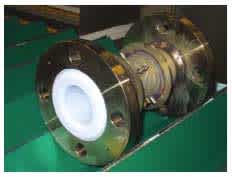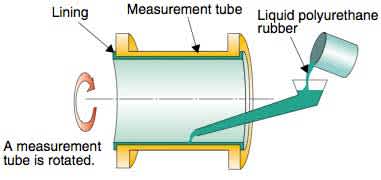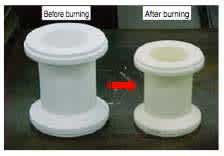OONISHI Yasuo1
The accuracy and reliability of magnetic flow meters, which play a key role in flow rate measurement, have become increasingly higher thanks to advances that have been made in electronics and the development of lining materials and manufacturing methods. This has led to the establishment of magnetic flow meters' position across a wide range of applications. Lining in the context of electromagnetic flow meters refers to applying resin or other alternative materials to the inner walls of a detector's measurement tube (metal pipe). Lining is important in order to efficiently detect generated very low electromotive force levels and ensure corrosion and abrasion resistance to the fluids being measured. The material for lining is selected according to the type of fluid to be measured. Using an in-house seamless process, Yokogawa produces every type of lining from raw materials to ensure high quality levels and realize minimum-cost production facilities and processes. This paper introduces the technologies for processing PFA, polyurethane rubber and ceramics which are our main lining materials for measurement tubes.
- Sourcing and Manufacturing Business Headquarters
INTRODUCTION
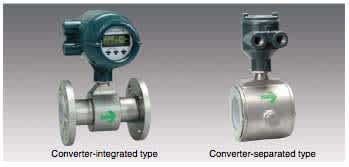 |
| Figure 1 Exterior Views of ADMAG AXF |
After having undergone several improvements, magnetic flow meters have become highly accurate and reliable and are widely used in the industrial instrument field today. Magnetic flow meters consist of a detector and a converter, with the principle of the detector adopting Faraday's electromagnetic induction law. This law states that if conductive fluid flows in a magnetic field, an electromagnetic force is generated in proportion to the fluid's flow velocity. Generally, the inner walls of a detector's measurement tube (metal pipe made of SUS, etc.) are lined with a relatively thick insulating layer to prevent the shorting of the generated electromotive force. This insulating layer is referred to as "lining." There are many kinds of lining materials available that provide corrosion and abrasion resistance to the fluids being measured.
This paper introduces three major variations of magnetic flow meters–namely, those using fuluoropolymer (PFA) lining, polyurethane rubber lining, and ceramic measurement tubes. The technology for manufacturing measurement tubes from ceramics, which is in itself an insulating material, is also presented. Figure 1 shows two new magnetic ADMAG AXF flow meters.
CONSTRUCTION OF MAGNETIC FLOW METER DETECTOR AND FEATURES OF VARIOUS LINING MATERIALS
- Construction of the Detector
Magnetic flow meters are constructed such that the inner walls of measurement tubes made of metal (SUS) are lined with a lining material as shown in Figure 2. In the case of PFA lining, SUS comprised punched plates are embedded in the inner walls to fasten the lining material to the measurement tube and simultaneously provide rigidity to restrict changes in the inner diameter. In contrast, for polyurethane rubber lining, the material is directly bonded and fixed to the measurement tube to achieve the same effects. Ceramic measurement tubes, on the other hand, have an inherent lining capability in and of themselves. - Features of Main Lining Materials
Table 1 shows the features of main lining materials.
Table 1 Features of Various Lining Materials
| Materials | Features |
|---|---|
| Fuluoropolymer (PFA) | · Superior in chemical and heat resistance · Superior in surface smoothness and adhesion resistance |
| Polyurethane rubber | · Superior in abrasion resistance · Has no heat or chemical resistance, but it is suitable for slurry fluid consisting mainly of water, muddy water, sea water, etc. |
| Soft natural rubber | · Shows less abrasion against slurry |
| EPDM rubber | · Superior in ozone resistance |
| Ceramic measurement tubes | · Superior in abrasion resistance (10 times or greater than that of polyurethane rubber) · Superior in heat and pressure resistance · Not suitable for highly concentrated alkaline solutions at high temperatures, phosphoric acid, fluoroxide, or fluorine compounds |
MANUFACTURING PROCESS OF LININGS
PFA Lining
 |
| Figure 2 Construction of a Magnetic Flow Meter Detector |
PFA is the abbreviation for perfluoro alkoxy resin, which is a type of fuluoropolymer. Fuluoropolymer has a variety of features and has been widely applied as an engineering plastic for industrial uses in chemical plants, etc. A familiar example of an application of PFA is as the Teflon coating used on some cooking utensils.
In Yokogawa, PFA lining accounts for 85% of the lining used in our magnetic flow meters, and is the lining material that has been produced in the greatest volume.
(1) PFA Lining Manufacturing Process
For the general fuluoropolymer lining of piping, tanks, etc., processing and bonding sheets to the inner faces of metal tubes or inserting a separate fuluoropolymer pipe into tubes is mainstream; however, for magnetic flow meters, a method of pouring and molding molten resin (the injection molding process) is the most common method. Our PFA lining is also formed using the injection molding process, resulting in a seamless, integral molding. An example of a flow meter to which PFA lining has been molded is shown in Figure 3.
Table 2 shows the differences between general resin molding and PFA lining. For general resin molding (the injection molding process), a single mold is used to carry out molding continuously and in large quantity, with the molding cycle completing in a time span ranging from several seconds to a few minutes. In contrast, PFA lining requires the adoption of a method that replaces the mold each time molding is conducted. This is due to our large variety, small lot production system and the fact that a mold that has been heated to a specific temperature must be loaded into a molding machine in an external mold changing process. The time required for changing molds during replacement is several tens of seconds, with the molding cycle itself taking from 10 minutes to an hour, far longer than that required for general resin molding, due to the high melt viscosity and temperatures of the fuluoropolymer.
Table 2 Differences between PFA Lining and General Resin Molding
| PFA Lining | General Resin Molding | |
|---|---|---|
| Molding method | Outsert molding Mold replacement each time molding is conducted |
Automatic die opening and closing Continuous operation |
| Resin's melting point | 305 to 315°C | 100 to 250°C |
| Melt viscosity | 104 to 105 poise | 102 to 103 poise |
| Molding time | 10 minutes to 1 hour | 5 seconds to 5 minutes |
| Mold temperature | Resin's melting point or higher | Room temperature to 200°C |
| Mold temperature adjustment | Multi-system independent | Uniform and consistent |
The construction of our molding machine is shown in Figure 4. The manufacturing process consists of the following five stages:
- Die assembly: A measurement tube (made of SUS) is assembled into a mold (die).
- Preheating mold: The mold is preheated to temperatures higher than resin's melting point.
- Resin injection: An injection molding machine injects molten resin into the mold.
- Cooling: The mold is cooled down to room temperature.
- Finish machining: The end surfaces of the molded parts are machined.
Figure 3 Flow meter with
Molded PFA Lining
(Example of Flange Type)(2) Production Control Points for PFA Lining
Yokogawa's PFA lining has been frequently applied under severe usage conditions such as in pulp and paper plants, chemical plants, and other fields. The qualities demanded of the PFA lining in such plants are chemical, heat, and adhesion resistance (surface roughness). Regarding chemical and heat resistance in particular, Yokogawa's unique manufacturing technology allows for the reduction of internal stress and boids, both of which are causes of cracks, resulting in a highly reliable PFA lining even when used under severe conditions. To realize these specifications, we underwent considerable trial and error with the molding facilities, mold improvements, and molding condition settings before arriving at our current method. The important control points in producing quality PFA linings are the molding temperatures (of both the resin and the mold itself), mold cooling control (cooling period and temperature), and resin pressure control. The following gives a general outline of these points:
- The molding temperature must be set to temperatures as low as possible to minimize thermal deterioration of the PFA resin.
- During molding, the temperature of the mold itself must be constant and higher than the resin's melting point. (This prevents weld lines and short shots.)
- Multiple cooling channels must be provided in the molds, and these must be independently cooling controlled to perform accurate cooling.
- Resin pressure control must be performed in synchronization with cooling control.
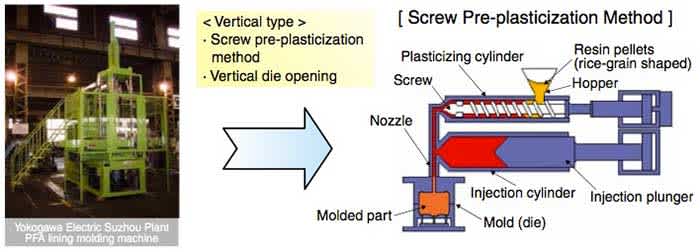
Figure 4 Construction of the PFA Lining Molding Machine
Polyurethane Rubber Lining
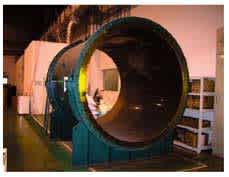 |
| Figure 5 Polyurethane Rubber Lined Pipe (Bore Diameter of 2,200 mm) |
In general, polyurethane is a flexible, strong form of resin used for cushion materials, fiber (clothing), etc. Our polyurethane lining accounts for only an approximate 5% of the linings of our magnetic flow meters; however, it accounts for most of the applications with a large bore size (inner diameters of 500 to 2,600 mm) as shown in Figure 5. This type of lining has been widely applied in plants such as water supply and sewerage fields.
Yokogawa uses a centrifugal casting method for molding linings (Figure 6). Because molds are only required for the end plates at both ends, this casting method can cope flexibly with differences in end-to-end distances. Moreover, it has the advantage of easily realizing a mirror-finished state, as the lining surface becomes free surface. As a matter of course, this method also provides seamless, integral molding.
(1) Polyurethane Lining Process
Yokogawa produces polyurethane lining using an in-house integrated process, from raw material processing to finishing. This process consists of the following five steps:
- Raw-material pretreatment: Dissolved gases are vacuum degassed from raw materials.
- Measurement tube pretreatment: Adhesive is applied to the inner faces of the tube.
- Material mixing and pouring: Base resin and hardener are mixed, polymerized, and poured into the inner walls of the rotating measurement tube.
Cross linking: The material is cured and allowed to complete a cross-linking reaction while being thermally insulated.
Figure 6 Principle Diagram of Centrifugal Casting Method - Finishing: Burrs are removed from the molded parts.
(2) Production control points of polyurethane rubber lining
The important control points in molding polyurethane rubber lining are the removal of air bubbles entrained during pouring, and the stabilization of chemical reactions that occur (curing and cross linking). The following gives a general outline of these points:
- The raw materials must be kept in a dry state during storage from the viewpoint of their properties.
- The raw materials must be mixed and agitated uniformly and smoothly.
- An appropriate rotational speed must be set to remove air bubbles entrained in the material.
- Material processing, curing, and cross-linking temperatures must be appropriately controlled.
CERAMIC MEASUREMENT TUBES
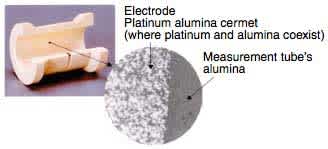 |
| Figure 7 Platinum Alumina Cermet Electrode |
For ceramic measurement tubes, the ceramic itself has an insulating quality making them inherently insulated. Yokogawa uses 99.9% alumina, which is a material that has been shown to be superior in strength and durability. Though ceramic is naturally fragile, this type of ceramic differs substantially from common ceramic ware and has the same tensile strength as that of steel (SS400).
Our ceramic measurement pipes account for 10% of the total magnetic flow meters that we produce, but they are being increasingly applied in fields where PFA lined flow meters cannot be used, due to their superior abrasion and heat resistance.
A significant feature of our ceramic pipes that is unique to Yokogawa, is our "platinum alumina cermet electrodes" in which the measurement tube body and the electrodes are integrally formed and burned (Figure 7). The alumina of the electrodes and of the measurement tube body is linked by sintering; thus leakage from the sealing at the electrodes is not an issue.
 |
| Figure 8 Principle Diagram of CIP Formation |
(1) Manufacturing Process of Ceramic Measurement Tubes
Yokogawa manufactures ceramic measurement tubes using an in-house integrated process, from raw material blending to burning and finishing. The manufacturing process consists of the following six steps:
- Raw material blending and granulation: Alumina powder is mixed with adhesive to form granules.
- Electrode formation: Alumina granules and platinum powder are mixed to form electrodes.
- CIP formation: Formation using cold isostatic pressing (CIP) is conducted. This principle is shown in Figure 8.
- Machining: Lathe machining is conducted according to the predicted shrinkage during burning.
- Burning: Ceramic shrinks by a dozen or so percentage points by burning (Figure 9).
- Finishing and inspection: 100% of our ceramic measurement tubes are thermal impact tested.
(2) Production control points of ceramic measurement tubes
Figure 9 Ceramic Shrinkage
due to BurningThe important control points in manufacturing ceramic measurement tubes are as follows:
- Optimum granulation conditions must be established to secure the strength of ceramic pipes.
- An appropriate platinum content must be established.
- Uniform and smooth CIP formation must be conducted.
- An accurate burning shrinkage must be predicted and communicated to the machining process.
- 100% of the ceramic measurement tubes produced must be thermal impact tested.
These control points facilitate the production of highly reliable, low cost ceramic measurement tubes.
CONCLUSION
The production plant for our magnetic flow meters has been transferred from Japan to Suzhou, China with the objective of becoming "Global No.1". We have been pushing ahead with our aim to achieve cost reductions and quality improvements while at the same time developing a consistent, volume production plant.
On the domestic front, we in Japan continue to be committed to working toward the development of new lining technology and new production equipment, focusing on the development of new products and core technologies.
REFERENCES
- YOSHIKAWA Osamu, et al., "New ADMAG AXF Series Magnetic Flow Meters," Yokogawa Technical Report, No. 37, 2004, pp. 15-20
- WATANABE Yoshimasa, et al., "A Key to Field Devices (Written by an Instrument Manufacturer)," Kogyogijyutsusha, 2001, pp. 69-83 (in Japanese)
- OKADA Takashi, "Ceramic Magnetic Flow Meters," Instrumentation, Vol. 35, No. 9, 1992, pp. 52-60 (in Japanese)
- KUROMORI Kenichi, et al., "ADMAG Series Magnetic Flow Meters Using Dual Frequency Excitation" Yokogawa Technical Report, Vol.32, No.3, 1988, pp.129-134 (in Japanese)
- 'Teflon' is the registered trademark of E. I. du Pont de Nemours and Company, USA.
Industries
-
Power
In the mid 1970s, Yokogawa entered the power business with the release of the EBS Electric Control System. Since then, Yokogawa has steadfastly continued with the development of our technologies and capabilities for providing the best services and solutions to our customers worldwide.
Yokogawa has operated the global power solutions network to play a more active role in the dynamic global power market. This has allowed closer teamwork within Yokogawa, bringing together our global resources and industry know-how. Yokogawa's power industry experts work together to bring each customer the solution that best suits their sophisticated requirements.
-
Water & Wastewater
All water, regardless of its source, has value. However, with water resources being finite, a focus on "One Water" is necessary to maximize every drop within the water system, ensuring a stable supply of clean and safe water. As we consider current and future needs, planning and implementation are critical for long-term resilience and reliability, meeting both community and ecosystem demands. Yokogawa believes water is a human right for all. Thus, contributing to a sustainable water cycle is one of our Sustainable Development Goals (SDGs).
Related Products & Solutions
-
ADMAG AXF
The AXF magnetic flow meter is a sophisticated product with outstanding reliability and ease of operation, developed on the basis of decades of field experience. Based on FOUNDATION™ fieldbus specifications, AXF Fieldbus Magnetic Flow meter models offer more flexible instrumentation.
-
Magnetic Flow Meters
Achieve stable measurement and quick response times.
